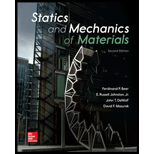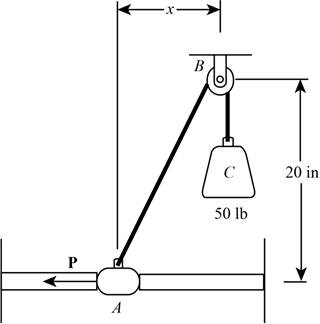
Statics and Mechanics of Materials
2nd Edition
ISBN: 9780073398167
Author: Ferdinand P. Beer, E. Russell Johnston Jr., John T. DeWolf, David Mazurek
Publisher: McGraw-Hill Education
expand_more
expand_more
format_list_bulleted
Concept explainers
Textbook Question
Chapter 2.3, Problem 49P

Cogar A is connected as shown to a 50-lb load and can slide on a frictionless horizontal rod. Determine the distance x for which the collar is in equilibrium when
Expert Solution & Answer
Want to see the full answer?
Check out a sample textbook solution
Students have asked these similar questions
PROBLEM 3.23
3.23 Under normal operating condi-
tions a motor exerts a torque of
magnitude TF at F. The shafts
are made of a steel for which
the allowable shearing stress is
82 MPa and have diameters of
dCDE=24 mm and dFGH = 20
mm. Knowing that rp = 165
mm and rg114 mm, deter-
mine the largest torque TF
which may be exerted at F.
TF
F
rG-
rp
B
CH
TE
E
1. (16%) (a) If a ductile material fails under pure torsion, please explain the failure
mode and describe the observed plane of failure.
(b) Suppose a prismatic beam is subjected to equal and opposite couples as shown
in Fig. 1. Please sketch the deformation and the stress distribution of the cross
section.
M
M
Fig. 1
(c) Describe the definition of the neutral axis.
(d) Describe the definition of the modular ratio.
using the theorem of three moments, find all the moments, I only need concise calculations with minimal explanations. The correct answers are provided at the bottom
Chapter 2 Solutions
Statics and Mechanics of Materials
Ch. 2.1 - 2.1 and 2.2 Determine graphically the magnitude...Ch. 2.1 - 2.1 and 2.2 Determine graphically the magnitude...Ch. 2.1 - Two structural members B and C are bolted to...Ch. 2.1 - Two structural members B and C are bolted to...Ch. 2.1 - The 300-lb force is to be resolved into components...Ch. 2.1 - The 300-lb force is to be resolved into components...Ch. 2.1 - A trolley that moves along a horizontal beam is...Ch. 2.1 - A disabled automobile is pulled by means of two...Ch. 2.1 - Two forces are applied as shown to a hook support....Ch. 2.1 - A disabled automobile is pulled by means of two...
Ch. 2.1 - A trolley that moves along a horizontal beam is...Ch. 2.1 - For the hook support shown, determine by...Ch. 2.1 - The cable stays AB and AD help support pole AC....Ch. 2.1 - Solve Prob. 2.4 by trigonometry.Ch. 2.1 - For the hook support of Prob. 2.9, determine by...Ch. 2.2 - 2.16 and 2.17 Determine the x and y components of...Ch. 2.2 - 2.16 and 2.17 Determine the x and y components of...Ch. 2.2 - 2.18 and 2.10 Determine the x and y components of...Ch. 2.2 - 2.18 and 2.19 Determine the x and y components of...Ch. 2.2 - Member BD exerts on member ABC a force P directed...Ch. 2.2 - Member BC exerts on member AC a force P directed...Ch. 2.2 - Cable AC exerts on beam AB a force P directed...Ch. 2.2 - The hydraulic cylinder BD exerts on member ABC a...Ch. 2.2 - Prob. 24PCh. 2.2 - Determine the resultant of the three forces of...Ch. 2.2 - Determine the resultant of the three forces of...Ch. 2.2 - Determine the resultant of the three forces of...Ch. 2.2 - For the collar loaded as shown, determine (a) the...Ch. 2.2 - Prob. 29PCh. 2.2 - A hoist trolley is subjected to the three forces...Ch. 2.2 - For the post loaded as shown, determine (a) the...Ch. 2.3 - Two cables are tied together at C and are loaded...Ch. 2.3 - 2.33 and 2.34 Two cables are tied together at C...Ch. 2.3 - Prob. 34PCh. 2.3 - Prob. 35PCh. 2.3 - Prob. 36PCh. 2.3 - Two forces of magnitude TA=8 kips and TB=15 kips...Ch. 2.3 - Prob. 38PCh. 2.3 - Prob. 39PCh. 2.3 - Two forces P and Q are applied as shown to an...Ch. 2.3 - Prob. 41PCh. 2.3 - A sailor is being rescued using a boatswains chair...Ch. 2.3 - For the cables of Prob. 2.32, find the value of a...Ch. 2.3 - Prob. 44PCh. 2.3 - Prob. 45PCh. 2.3 - Prob. 46PCh. 2.3 - Two cables tied together at C are loaded as shown....Ch. 2.3 - Collar A is connected as shown to a 50-1b load and...Ch. 2.3 - Cogar A is connected as shown to a 50-lb load and...Ch. 2.3 - A movable bin and its contents have a combined...Ch. 2.3 - A 600 lb crate is supported by several...Ch. 2.3 - Prob. 52PCh. 2.3 - A 200-kg crate is to be supported by the...Ch. 2.3 - Prob. 54PCh. 2.3 - Prob. 55PCh. 2.4 - Determine (a) the x, y, and z components of the...Ch. 2.4 - Determine (a) the x, y, and z components of the...Ch. 2.4 - The end of the coaxial cable AE is attached to the...Ch. 2.4 - The end of the coaxial cable AE is attached to the...Ch. 2.4 - A gun is aimed at a point A located 35 east of...Ch. 2.4 - Prob. 61PCh. 2.4 - Determine the magnitude and direction of the force...Ch. 2.4 - Prob. 63PCh. 2.4 - Prob. 64PCh. 2.4 - Prob. 65PCh. 2.4 - Prob. 66PCh. 2.4 - Prob. 67PCh. 2.4 - Prob. 68PCh. 2.4 - Prob. 69PCh. 2.4 - In order to move a wrecked truck, two cables are...Ch. 2.4 - In order to move a wrecked truck, two cables are...Ch. 2.4 - Prob. 72PCh. 2.4 - Prob. 73PCh. 2.4 - Knowing that the tension is 425 lb in cable AB and...Ch. 2.4 - Knowing that the tension is 510 lb in cable AB and...Ch. 2.4 - A frame ABC is supported in part by cable DBE that...Ch. 2.4 - For the plate of Prob. 2.68, determine the...Ch. 2.4 - The boom OA carries a load P and is supported by...Ch. 2.4 - For the boom and loading of Prob. 2.78, determine...Ch. 2.5 - A container is supported by three cables that are...Ch. 2.5 - A container is supported by three cables that are...Ch. 2.5 - A crate is supported by three cables as shown....Ch. 2.5 - A crate is supported by three cables as shown....Ch. 2.5 - A crate is supported by three cables as shown....Ch. 2.5 - A 1600-lb crate is supported by three cables as...Ch. 2.5 - Three wires are connected at point D, which is...Ch. 2.5 - Prob. 87PCh. 2.5 - A rectangular plate is supported by three cables...Ch. 2.5 - A rectangular plate is supported by three cables...Ch. 2.5 - Prob. 90PCh. 2.5 - Solve Prob. 2.90, assuming that a fiend is helping...Ch. 2.5 - Prob. 92PCh. 2.5 - Prob. 93PCh. 2.5 - Prob. 94PCh. 2.5 - Prob. 95PCh. 2.5 - Prob. 96PCh. 2.5 - Prob. 97PCh. 2.5 - Prob. 98PCh. 2.5 - Prob. 99PCh. 2.5 - Prob. 100PCh. 2.5 - Prob. 101PCh. 2.5 - Prob. 102PCh. 2.5 - Solve Prob. 2.102 assuming that y=275mm.Ch. 2 - Two structural members A and B are bolted to a...Ch. 2 - Determine the x and y components of each of the...Ch. 2 - The hydraulic cylinder BC exerts on member AB a...Ch. 2 - Prob. 107RPCh. 2 - Knowing that a=20, determine the tension (a) in...Ch. 2 - Prob. 109RPCh. 2 - Prob. 110RPCh. 2 - Prob. 111RPCh. 2 - Prob. 112RPCh. 2 - Prob. 113RPCh. 2 - A transmission tower is held by three guy wires...Ch. 2 - Prob. 115RP
Knowledge Booster
Learn more about
Need a deep-dive on the concept behind this application? Look no further. Learn more about this topic, mechanical-engineering and related others by exploring similar questions and additional content below.Similar questions
- PROBLEM 3.46 The solid cylindrical rod BC of length L = 600 mm is attached to the rigid lever AB of length a = 380 mm and to the support at C. When a 500 N force P is applied at A, design specifications require that the displacement of A not exceed 25 mm when a 500 N force P is applied at A For the material indicated determine the required diameter of the rod. Aluminium: Tall = 65 MPa, G = 27 GPa. Aarrow_forwardFind the equivalent mass of the rocker arm assembly with respect to the x coordinate. k₁ mi m2 k₁arrow_forward2. Figure below shows a U-tube manometer open at both ends and containing a column of liquid mercury of length l and specific weight y. Considering a small displacement x of the manometer meniscus from its equilibrium position (or datum), determine the equivalent spring constant associated with the restoring force. Datum Area, Aarrow_forward
- 1. The consequences of a head-on collision of two automobiles can be studied by considering the impact of the automobile on a barrier, as shown in figure below. Construct a mathematical model (i.e., draw the diagram) by considering the masses of the automobile body, engine, transmission, and suspension and the elasticity of the bumpers, radiator, sheet metal body, driveline, and engine mounts.arrow_forward3.) 15.40 – Collar B moves up at constant velocity vB = 1.5 m/s. Rod AB has length = 1.2 m. The incline is at angle = 25°. Compute an expression for the angular velocity of rod AB, ė and the velocity of end A of the rod (✓✓) as a function of v₂,1,0,0. Then compute numerical answers for ȧ & y_ with 0 = 50°.arrow_forward2.) 15.12 The assembly shown consists of the straight rod ABC which passes through and is welded to the grectangular plate DEFH. The assembly rotates about the axis AC with a constant angular velocity of 9 rad/s. Knowing that the motion when viewed from C is counterclockwise, determine the velocity and acceleration of corner F.arrow_forward
arrow_back_ios
SEE MORE QUESTIONS
arrow_forward_ios
Recommended textbooks for you
 International Edition---engineering Mechanics: St...Mechanical EngineeringISBN:9781305501607Author:Andrew Pytel And Jaan KiusalaasPublisher:CENGAGE L
International Edition---engineering Mechanics: St...Mechanical EngineeringISBN:9781305501607Author:Andrew Pytel And Jaan KiusalaasPublisher:CENGAGE L

International Edition---engineering Mechanics: St...
Mechanical Engineering
ISBN:9781305501607
Author:Andrew Pytel And Jaan Kiusalaas
Publisher:CENGAGE L
EVERYTHING on Axial Loading Normal Stress in 10 MINUTES - Mechanics of Materials; Author: Less Boring Lectures;https://www.youtube.com/watch?v=jQ-fNqZWrNg;License: Standard YouTube License, CC-BY